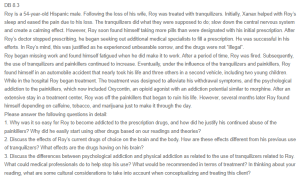Prescription Drug Misuse and Dual Addiction – A Case of Grief and Self-Medication
Ease of Addiction and Justification
Specifically, using prescription medications such as Xanax, a 54-year-old Hispanic male named Roy developed an addiction after his wife’s death, finding that these substances helped him cope with grief and anxiety. He justified its prolonged usage because they thought prescription drugs were safe and needed. This led him to seek other drugs, including Oxycontin, caffeine and tobacco, as well as marijuana for managing withdrawal symptoms and any feelings of emotional pain that did not disappear as he used drugs to self-medicate.
Effects of Current Drugs
Caffeine, tobacco and marijuana are different from tranquilizers in how they act on Roy’s brain and body. The two stimulants are caffeine and nicotine, and while they make the person alert, they have negative effects such as anxiety and may also lead to cardiovascular diseases. Marijuana has violent depressive and hallucinogenic properties that cause disruption of brain functions and depressive disorders (Pesta et al., 2023). These substances do not treat the original cause of anxiety or grief that made Roy turn to tranquilizers, thereby potentially aggravating his psychological condition.
Psychological vs. Physical Addiction and Treatment Recommendations
Roy was not only psychologically dependent but also physically dependent on the tranquilizers. In essence, psychologically, he relied on them so that he could not feel the pain and physically, he became tolerant, and he even developed withdrawal symptoms when he was not using the substance (Clemente-Suárez et al., 2021). Roy can only be assisted by medical professionals who can address both elements by means of a full detoxification process, cognitive behaviour therapy, and possibly non-narcotic medication for anxiety. One cultural factor is the Hispanic origin of Roy (Health (US) & Study, 2020); this might affect his perception of drugs or the way he perceives psychiatric treatment; this makes the treatment plan culturally appropriate and easily available.
References
Clemente-Suárez, V. J., Ruisoto, P., Isorna-Folgar, M., Cancelo-Martínez, J., Beltrán-Velasco, A. I., & Tornero-Aguilera, J. F. (2021). Psychophysiological and Psychosocial Profile of Patients Attending Drug Addiction Centers. Applied Psychophysiology and Biofeedback, 47(2), 77–84. https://doi.org/10.1007/s10484-021-09531-1
Health (US), N. I. of, & Study, B. S. C. (2020). The Essence of Drug Addiction. In www.ncbi.nlm.nih.gov. National Institutes of Health (US). https://www.ncbi.nlm.nih.gov/books/NBK20368/
Pesta, D. H., Angadi, S. S., Burtscher, M., & Roberts, C. K. (2023). The effects of caffeine, nicotine, ethanol, and tetrahydrocannabinol on exercise performance. Nutrition & Metabolism, 10(1), 71. https://doi.org/10.1186/1743-7075-10-71
ORDER A PLAGIARISM-FREE PAPER HERE
We’ll write everything from scratch
Question

A Case of Grief and Self-Medication
DB 8.3
Roy is a 54-year-old Hispanic male. Following the loss of his wife, Roy was treated with tranquilizers. Initially, Xanax helped with Roy’s sleep and eased the pain due to his loss. The tranquilizers did what they were supposed to do; slow down the central nervous system and create a calming effect. However, Roy soon found himself taking more pills than were designated with his initial prescription. After Roy’s doctor stopped prescribing, he began seeking out additional medical specialists to fill a prescription. He was successful in his efforts. In Roy’s mind, this was justified as he experienced unbearable sorrow, and the drugs were not “illegal”.
Roy began missing work and found himself fatigued when he did make it to work. After a period of time, Roy was fired. Subsequently, the use of tranquilizers and painkillers continued to increase. Eventually, under the influence of the tranquilizers and painkillers, Roy found himself in an automobile accident that nearly took his life and three others in a second vehicle, including two young children. While in the hospital Roy began treatment. The treatment was designed to alleviate his withdrawal symptoms, and the psychological addiction to the painkillers, which now included Oxycontin, an opioid agonist with an addiction potential similar to morphine. After an extensive stay in a treatment center, Roy was off the painkillers that began to ruin his life. However, several months later Roy found himself depending on caffeine, tobacco, and marijuana just to make it through the day.
Please answer the following questions in detail:
1. Why was it so easy for Roy to become addicted to the prescription drugs, and how did he justify his continued abuse of the painkillers? Why did he easily start using other drugs based on our readings and theories?
2. Discuss the effects of Roy’s current drugs of choice on the brain and the body. How are these effects different from his previous use of tranquilizers? What effects are the drugs having on his brain?
3. Discuss the differences between psychological addiction and physical addiction as related to the use of tranquilizers related to Roy. What could medical professionals do to help stop his use? What would be recommended in terms of treatment? In thinking about your reading, what are some cultural considerations to take into account when conceptualizing and treating this client?

